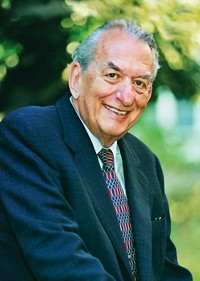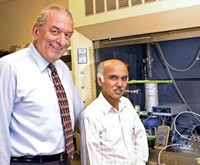Advertisement
Grab your lab coat. Let's get started
Welcome!
Welcome!
Create an account below to get 6 C&EN articles per month, receive newsletters and more - all free.
It seems this is your first time logging in online. Please enter the following information to continue.
As an ACS member you automatically get access to this site. All we need is few more details to create your reading experience.
Not you? Sign in with a different account.
Not you? Sign in with a different account.
ERROR 1
ERROR 1
ERROR 2
ERROR 2
ERROR 2
ERROR 2
ERROR 2
Password and Confirm password must match.
If you have an ACS member number, please enter it here so we can link this account to your membership. (optional)
ERROR 2
ACS values your privacy. By submitting your information, you are gaining access to C&EN and subscribing to our weekly newsletter. We use the information you provide to make your reading experience better, and we will never sell your data to third party members.
People
Olah Wins 2005 Priestley Medal
Nobel Laureate's research driven by questions of future global energy
by Mitch Jacoby
April 5, 2004
| A version of this story appeared in
Volume 82, Issue 14
George A. Olah, the Donald P. & Katherine B. Loker Distinguished Professor of Organic Chemistry at the University of Southern California (USC), has been named the 2005 Priestley Medalist. The annual award, which recognizes distinguished services to chemistry, is the American Chemical Society's highest honor.
Olah, who is director of USC's Loker Hydrocarbon Research Institute, is known throughout the chemistry community for his contributions to organic synthesis and mechanistic chemistry and most notably for his work in carbocation chemistry, for which he won the 1994 Nobel Prize in Chemistry.
"I'm very appreciative of the honor," Olah said at last week's ACS national meeting in Anaheim, Calif., where the announcement was made. The 76-year-old chemist is particularly pleased, he remarked, "because the award acknowledges work done over a long period of time."
Indeed, during the course of a chemistry career that's now in its sixth decade, Olah and coworkers have made numerous advances in fundamental and applied chemistry. The USC researcher is well known, for example, for developing a variety of superacids--combinations of Lewis and Brønsted acids such as HF-SbF5--that are billions of times stronger than sulfuric acid. Using superacids as solvents for alkyl halides and in ion-generating reactions, Olah developed a technique to extend the lifetimes of carbocations and other typically short-lived ionic species so they could be probed directly using nuclear magnetic resonance spectroscopy, X-ray photoelectron spectroscopy, and other methods.
"The techniques pioneered by Olah for the direct spectroscopic observation of carbocations are now being applied in organometallic, synthetic organic, bioorganic, and industrial chemistry," remarks University of Utah chemistry professor Peter J. Stang. He adds that Olah's work was the inspiration that led to thousands of publications from numerous laboratories worldwide, "making the study of reactive intermediates one of the most active fields of investigation in all of chemistry in the last 40 years."
In addition to pioneering work with superacids, Olah is recognized for developing novel electrophiles, including doubly electron-deficient species that have played key roles in Friedel-Crafts alkylations and other reactions. And the USC scientist is credited with developing safe and environmentally benign procedures for preparing high-octane fuels.
For years, Olah's research program has been driven by questions regarding future global energy sources. Unlike some proponents of the hydrogen economy, Olah sees great advantages in using methanol--not hydrogen--to store and dispense energy.
Working toward his vision of a "methanol economy," Olah and coworkers at USC and the Jet Propulsion Laboratory in Pasadena, Calif., have developed a direct methanol fuel cell for generating electrical power from methanol without first producing hydrogen.
More than 50 years after beginning a professorship at Budapest Technical University in Hungary, Olah remains active and enthusiastic about chemistry research. "The work I'm doing now may be some of the most interesting and perhaps most significant work I've ever done," he said.






Join the conversation
Contact the reporter
Submit a Letter to the Editor for publication
Engage with us on Twitter